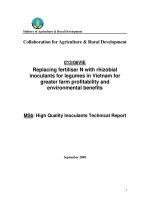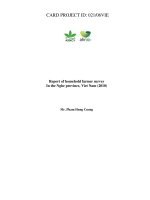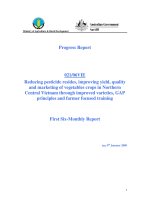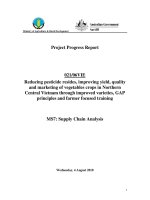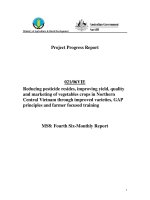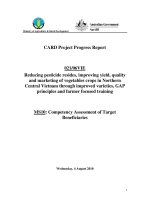Báo cáo khoa học nông nghiệp " Treating and recycling waste and soils from fish ponds in the Mekong Delta to improve livelihood and reduce water pollution" pdf
Bạn đang xem bản rút gọn của tài liệu. Xem và tải ngay bản đầy đủ của tài liệu tại đây (615.13 KB, 18 trang )
&:
!=n.
I.$.
.!wB;?,
, +
:
Australian Government
.:.A>.
:;
;
.',
;;
* 72;-*st"A;A
;-:-::c:
9:
.z4.:
Ministry of Agriculture
&
Rural Development
,:'
AUS
AID
Project Progress Report
023/06VIE
Treating and recycling waste water and solids from
fish ponds
in
the Mekong Delta to improve
livelihood and reduce water pollution
+
<
.:t
MS2: FIRST SIX-MONTHLY REPORT
7"'
January,
2008
Table of Contents
1. Institute In formation 1
2.
Project Abstract
2
3.
Executive Summary
2
4.
Introduction
&
Background
3
5.
Progress to Date
5
5.1 Implementation Highlights
5
5.2 Smallholder Benefits
9
5.3 Capacity Building
9
5.4 Publicity
9
5.5 Project Management
9
6.
Report on Cross-Cutting Issues
9
6.1 Environment
9
6.2 Gender and Social Issues
9
7.
Implementation
&
Sustainability Issues 10
7.1 Issues and Constraints 10
7.2 Options 10
7.3 Sustainability 10
8.
Next Critical Steps 10
9. Conclusion 11
10. Statuatory Declaration 11
1.
Institute Information
Contact
Officer(s)
Project Name
Vietnamese Institution
Vietnamese Project Team Leader
In Australia: Team Leader
023106VIE
Cuu Long Rice Research Institute
Dr. Cao van Phung
Name: Richard Bell
Position: Professor
Organisation Murdoch University
Australian Personnel Dr. Richard Bell
Date commenced April
2007
Completion date (original)
February
20 10
Completion date (revised)
March
20 10
Reporting period April- October
2007
In Australia: Administrative contact
Name: Richard
McCulloch
Position: General Manager
Organisation Murdoch Link
In Vietnam
Name: Cao Van Phung
Position: Head, Soil Science Dept.
Organisation Cuu Long Rice Research
Institute
Telephone:
+61 8 93602370
Fax:
+6 1 8 93 104997
Email:
Telephone:
+61 8 93607566
Fax:
Email:
Telephone:
+84 71 861452
Fax:
+8471861457
Email: phungcv@,vahoo.com.vn
2.
Project Abstract
-
The use of fishpond waste at Chau Phu and Phu Tan districts of An Giang
province showed that fishpond waste by farmers increased rice yield significantly
about
1
tonneha because solid waste from fishpond has higher content of
available nitrogen, phosphorus, potassium, calcium, magnesium as well as
micronutrients.
-
A field experiment was conducted using three doses of solid wastes (1, 2 and 3
tonneha) in combination with 113 and 213 of the recommended inorganic
fertilisers rate
(60N-40P205-30K20). Rice yields are more or less the same in all
treatment, suggesting that the fishpond waste
relaced 113 to 213 of the fertiliser
normally applied. The results again confirmed that solid waste from fishpond can
be recycled for rice culture to mitigate pollution of waterway.
-
Denitrification bacteria
(Pseudomonas stutzeri)
caused ammonia, nitrite and
nitrate concentrations in waste-water from fishpond t decrease strongly from
9
mg5 to below 1 mg5 (NlaN7a) and 0 mg/L (N2aD3b) after 2 days, meanwhile
ammonia concentration of control treatment only decreased from
9
to
7
mg/L.
3.
Executive
Summary
-
Questionnaires for baseline study were formulated in consultation with researchers of
Can Tho University, and with extension officers in Can Tho city and An Giang
provinces. In total 240 questionnaires of stakeholders were collected (2
districtslsite).
The preliminary results showed that all stakeholders were concerned about surface
water pollution because of its effects on their business sustainability and livelihood.
There were about 20
%
of the farmers (including both fish and rice farmers) stating
that water quality is bad. There are only
5% of fishpond holders having settling
ponds, 12
%
of them practice waste recycling on paddies and the rest discharge
directly to the waterway. Farmers practicing fish culture are richer, high educated and
younger than those carrying out rice cultivation. However, about 15
%
of fishpond
holders are recent migrants who have bought or rented lands from local farmers.
Impacts reported on water quality include greenish-black colour, bad smell, high
turbidity, causing itching on contact. Moreover, farmers raising fish recognised that
percentages of diseases infected. fish is much higher (about 15%) than before
(<
5
%).
The demand for effective and economical solutions for control of water pollution is
the first priority of stakeholders.
-
The survey of farmers' practices on fishpond waste treatment was completed during
the dry season 2007 at 2 sites (An Giang province and Can Tho city). Most of the
wastes (liquid and solid) are
pumped directly into waterways (rivers or canals). In the
case of fishponds located nearby big rivers
(Tien and Hau), waste is apparently
diluted by the large volume of water flow and it is not reported to cause much
problem in comparison with discharge situated at the far end of small rivers or canals.
Under some circumstances, waste was discharge into paddy fields. A concern
requiring management arises mainly due to high content of nitrogen in waste causing
yield loss by lodging. However, a judicious use of waste in balance with inorganic
fertiliser application may increase rice yield in some cases.
-
During the dry season 2007, we conducted a study on "Effect of waste application on
rice yield in An Giang province". We selected 32 paddies wherein 16 fields received
waste through discharges from fishponds while the others did not. Results showed
that rice yields in fields receiving waste were 0.8-1.0
tonneslha higher than those that
did not receive waste. This might be due to high nutrient content in waste especially
available nitrogen, phosphorus, potassium as well as secondary and micronutrients.
-
A field study on the beneficial use of solid fishpond waste for rice cultivation was
carried out during the wet season 2007 at the experimental farm of Cuu Long Rice
Research Institute. Three dosages of waste at the rate of 1, 2 and 3
tonnesha were
applied in combination with 113 and
213 dosages of inorganic fertilisers. The 100 %
rate of inorganic fertilisers (60N-40PzOs-30K20) served as the control. There were no
significant differences in rice yields over all treatments. This indicated that uses of
solid waste from fishpond can save money for farmers by reducing fertiliser inputs.
-
The analysis of water collected from fish ponds indicated that it is high in water
soluble nitrogen, total suspended solids while coliform bacteria was at the limits
under regulation
No.212006 of the Ministry of Fishery\ies.
-
Eight isolates and one strain of denitrifying bacteria
Pseudomonas stuzeri
were
collected
from fishponds in the Cuu Long Delta for microbial treatment of waste
water. Results showed that ammonium contents in waste water treated with
denitrifying bacteria decreased quickly from 10
mgL at day 0 to 0 mgL at day 4.
Meanwhile in BKC and control treatments, ammonia remained at 2
mg/L after 4
days. Nitrite concentration in control treatment increased up to 3
mgL at day 2. Other
treatments maintained nitrite level below 0.5
mgL. Nitrate was detected only in
control tank at day 4. It might be concluded that BKC and denitrifying bacteria has
the ability to reduce nitrite and nitrate in waste water, however, further experiments
will be undertaken to determine the fate of the ammonium lost from solution.
4.
Introduction
8
Background
Fishpond aquaculture is as a major industry in the Mekong Delta. However, wastewater and
solid waste discharge from fish ponds is causing pollution of canals and rivers harming the
quality of water used for household purposes and threatening the future of the aquaculture
industry itself. There is a clear and urgent need to develop strategies for reducing waste
discharge from fish ponds so that the fishpond aquaculture industry can continue to support
income diversification in the Mekong Delta, while complying with the water quality
discharge standards outlined in Vietnamese law and regulations (Ministry of Fisheries
2006)'.
Water in fish ponds is replaced frequently generating large quantities for disposal or re-use.
Currently wastewater is mostly discharged into communal rivers and canals, but this has
caused significant downstream water pollution, such that most of the aquaculture is now
located in the headwaters of catchments.
In
order to reduce pollution, National
Environmental Law introduced in 2005 prohibits direct wastewater discharge into rivers and
canals. Offenders may either be fined or their operation closed until compliance is achieved.
In addition annual emptying and cleaning of solid waste from the base of fish ponds is
essential to control the spread of diseases among fish. This produces an organic-rich
sluny
comprising about 35
%
solids. Discharging this slurry into communal waterways is also
-
1
Ministry of Fisheries
(2006).
Maximum concentration limits allowable for pollutants discharged to
waterways. Regulation No.
02/2006.
Issued March
2006.
prohibited under the law. However, there appears to be poor compliance with the law in
discharge from fish ponds. Strict compliance with the law without cost-effective treatment
and recycling strategies would have a crippling effect on the fishpond aquaculture industry. It
is critically important to develop effective strategies for fishpond operators so that they can
treat wastewater and solid wastes to meet discharge standards without large costs.
While there is widespread acceptance that water pollution from fishpond discharge is
prevalent, there appears to be little evidence gathered and published on the problem. In
particular there appears to be a lack of baseline water quality data from which to demonstrate
a decline in water quality. Moreover, there is little current monitoring of water quality in the
medium to small sized canals in which the water pollution problem is most obvious. Hence it
remains unclear what water parameters fail to meet the Vietnamese water quality standards,
how frequently breaches occur, where they occur and the key risk factors. From first
principles, it is likely that the water pollution problems are most severe during the dry season
when flushing and mixing of discharge water is least, and in the smaller canals especially
where their flow is blocked by aquatic plants and by barriers.
The Mekong Delta produces 400,000 t of catfish per annum mostly in freshwater ponds.
Most of the fish are exported to the USA, and increasingly to European countries and Japan.
The exported fish must meet sanitary requirements in these markets.
A
major variable in
producers' capacity to control the inputs to fish ponds is the water used to fill ponds, which is
drawn
from rivers and canals. However, under the cumulative influence of intensive fishpond
aquaculture, a decline in quality of river and canal water from the discharges is limiting
productivity and expansion of fishpond aquaculture by causing the downstream spread of
bacterial disease and parasites in the water. It may also be impacting adversely on the health
of families that draw significant amounts of their domestic water from these polluted sources.
The challenge of this project is to protect the fishpond aquaculture industry which is a source
of diversified income for farmers in the Mekong delta by treating the waste water and solids
from fish ponds, whilst at the same time protecting the environment and householder users
from water pollution.
The expected outputs are directed to improving competitiveness of fishpond aquaculture
producers in the Mekong Delta. In addition, technologies to be developed will improve
natural resources management by decreasing water pollution from uncontrolled discharge of
fishpond waste water and solids into rivers and canals. The overall Project objective is to
improve the sustainability of fishpond aquaculture production and water quality in the
Mekong Delta. Specific Project objectives are:
e
Develop effective treatment strategies for wastewater and solids from
fishponds before discharge to reduce water pollution;
e
Develop resource recovery and re-use strategies for waste water and solids
from fish ponds including land application and novel end uses;
0
Increase stability of household income from fishpond aquaculture through
encouraging diversification of production and markets in the Mekong Delta.
This project targets fishpond aquaculture, not other types of aquaculture such as cage
aquaculture and shrimp aquaculture. Cage aquaculture is declining in importance due to
rising costs and riskiness of the production system compared to pond culture. Other studies
have examined shrimp aquaculture in brackish water environments (Be,
1997).
Shrimp
aquaculture is also under threat due to environmental impacts. Hence, there are lessons to be
learnt from other forms of aquaculture, in particular the need to address environmental issues
that can impact on the sustainability of the industry even when economics for it are
favourable.
Fishpond aquaculture is practiced by three main groups in the Mekong Delta: farmers using
the VAC system to recycle waste water and solid wastes from fish ponds; small farmers who
have both fish ponds and crop land but without integration of these components of the farm;
specialist producers who essentially use all of their land for fish ponds. The VAC system
already practices re-cycling of wastewater and solid waste to recover nutrient resources. In so
doing the level of pollution caused by water discharge is probably decreased. However, there
appears to be little evidence to demonstrate the benefits of the VAC system for downstream
water quality. The present project will assess the impact of the VAC system on water quality
in downstream canals, and as necessary examine modifications to the recycling of
wastewater and solid waste in order to meet water quality standards for discharge. The
second group of producers comprises small farmers who have a few fish ponds within a farm
carrying out crop production for padi
andlor fruit trees and vegetables. The present Project is
particularly relevant to these two groups of producers who have sufficient land for
wastewater and solid waste treatment by re-cycling, but are currently discharging wastewater
and solid wastes directly into canals.
Both liquid and solid waste
from aquaculture contain carbon and nutrients which can
be
recycled on farms to boost production of rice, vegetables and fruit trees, as well as novel
products for small scale agro-industry. Solid wastes can be treated in a number of ways,
including land application, vermi-composting, microbially-activated decomposition and
ozone treatment. However, research is needed to ascertain the potential of each method for
treating wastes and improving water quality, and to gather evidence of their effectiveness in
meeting water quality outcomes.
The specialist fishpond producers generally have inadequate land remaining for recycling
wastewater and solid waste. Currently wastes are discharged directly into canals and rivers,
sometimes after treatment with biocides. Further investigation is needed to determine the
impacts of biocides on the downstream environment. In addition, opportunities need to be
explored for cooperative arrangements that allow the disposal of wastewater and solid wastes
from the specialist producers onto neighbouring farmers' land. However, the best practices
for carrying this out still need to be developed, and once established can be extended to this
group of producers.
5.
Progress to
Date
5.1
Implementation Highlights
Baseline study: Questionnaires for baseline study were formulated in consultation with
researchers of Can Tho University, and with extension officers in Can Tho city and
An
Giang
provinces. The survey was conducted in September and October, 2007. In total 240
questionnaires of stakeholders were collected (2
districts/province). Data is now being
analysed by the Department of Socio-Economics of Cuu Long Rice Research Institute.
Preliminary results showed that all
stakeholders were concerned about surface water
pollution because of its impacts on sustainability of production and livelihoods. There were
about 20
%
of the farmers (including both fish and rice farmers) stating that water quality is
bad. There are only
5
%
of fishpond holders having settling ponds, 12
%
of fishpond farmers
practice waste recycling on paddies and the rest discharge directly to the waterway. Farmers
practicing fish culture are richer, better educated and younger than those carrying out rice
cultivation, based on numbers of concrete houses, living commodities, pumping machines
and incomes. However, about 15
%
of fishpond holders are recent migrants who have bought
or rented lands from local farmers. Impacts reported on water quality include greenish-black
colour, bad smell, high turbidity, and skin itching on contact. Moreover, farmers raising fish
recognised that percentages of diseases infected fish is much higher (about 15%) than before
(<
5
%).
The demand for effective and economical solutions for control of water pollution is
the first priority of stakeholders. The investment for raising fish is large and most of farmers
is lending either from bank or their neighbours hence they are concerned about threats to the
viability of the operation.
Survey of farmers' practices on fishpond waste treatment: The survey of farmers' practices
on fishpond waste treatment was completed during the dry season 2007 at 2 sites (An Giang
province and Can Tho city). Most of the wastes (liquid and solid) are pumped directly into
waterways (rivers or canals). In the case of fishponds located nearby large rivers
(Tien and
Hau), waste is apparently diluted by the large volume of water flow and it is not reported to
cause much problem in comparison with discharge situated at the far end of small rivers or
canals. Under some circumstances, waste was discharge into paddy fields. A concern
requiring management arises mainly due to high content of nitrogen in waste causing rice
yield loss by lodging. However, a judicious use of waste in balance with inorganic fertiliser
application may increase rice yield in some cases.
During the dry season 2007, we conducted a study on "Effect of waste application on rice
yield in An Giang
provinceyy. We selected 32 paddies wherein
16
fields received waste
through discharges from fishponds while the others did not. Results showed that rice yields
in fields receiving waste were 0.8-1.0
tonneslha higher than those that did not receive waste
(Table 1). This might be due to high nutrient content in waste especially available nitrogen,
phosphorus, potassium as well as secondary and micronutrients (Table 2). However, organic
carbon content in paddies receiving waste were lower. This problem is under studying to
clarify whether farmer used only liquid waste for irrigation.
Table
1. Average rice yields (tha) in paired sites in An Giang province with and without
fishpond sediment application. Values are means of 8 replicates.
Water
qualitv sampling: Three study areas have been selected: Chau Phu and Phu Tan in An
Giang Province; Thot Not in
Cantho district. In addition, water sampling is proposed for
Binh Thuy and Phong Dien districts near
Cantho city, in areas practising VAC.
Without fishpond sediment
6.9
6.6
District
Chau phu
Phu Than
Table 2. Pond sediment composition from survey in An Giang province, 2007
Plus fishpond sediment
7.9
7.4
Element
C
N
P
K
Concentration
2.5
%
0.83
%
0.61
%
3.5
%
The sampling proposed for
8
ponds was as follows:
Pond water (surface),
Pond water (2 m depth),
Drain water at gate
Downstream 100-200
m
Plan is for sampling 2 times per month for
5
months.
Waste recycling
practiced
Some farmers use
liquid waste from
fish ponds for rice
cultures
Controversies on
liquid waste
application on rice
Settling pond, tree
lot irrigation, rice
padi application
Landfill on orchard,
watering vegetable
and rice
Landfill on orchard,
watering vegetable
and rice
Water quality measurements proposed:
Chemical properties: pH, EC, BOD, COD,
Nos,
P,
S,
Biological properties:
E
coli, Total coliform, Staphyllococcus, Salmonella.
Feeding
Own feed
mixing plus
pellets
Own feed
mixing plus
pellets
Pellets and
own feed
mixing
Pellets
feeding at
fingerling
about 1 month
then own feed
mixing
Pellets
feeding at
fingerling
about
1
month
then own feed
mixing
However, a number of factors should be considered in sampling:
1. Control sites- Most catchments will have background inputs of pollutants to canal water
from rice farming, and human settlements. The background impact of these on water quality
needs to be determined by water sampling at control sites beyond the influence of fishponds.
The location of the control sites will vary from site to site.
2. Low tide sampling- During low tide water drains out of the catchment and at this time
discharge of wastewater is most likely. Sampling should coincide with such periods of
discharge to capture the peak in pollution events.
3.
High tide sampling- During high tide back flow of water from rivers and main canals to
small canals occurs. Refilling of fish ponds is likely during these times. Sampling should also
be planned to coincide with such periods of discharge to capture the base load in pollution
events.
Closest drainage
Small drain
discharging
through gates to
large canal
Discharging
through gates to
small canal
Mainly to canals,
some was
discharged on
padi
Small canal
Small canal
District
Chau Phu
Phu Tan
ThotNot
Binh Thuy
Phong Dien
Aquaculture
system
Large fishponds,
recent
development
Large fishponds,
recent
development
Large fishponds,
operating
8
years
Small fishponds
Small fishponds
4. Sampling protocols- Cantho University has a set of sampling protocols. Protocols should
describe sampling locations (depth, distance from bank), cleaning of sampling bottles,
storage conditions for samples after collection.
5.
GPS positioning of sampling sites- To ensure sampling is repeated at the same positions
GPS coordinates should be taken for sites.
6. Water
quality- after the MSc student finishes sampling in December, further dry season
sampling is needed to provide a complete view of the annual cycle of pollution from
fishpond waste water.
7. After results are available for the first 4 sampling periods, a summary of the data should be
circulated to Murdoch so that the project can discern trends and determine whether variation
in sampling plans can be made.
8. The variables expected to contribute to pollution levels from fishpond waste water are:
size of the canal into which discharge occurs; tide level;
time of the year;
distance from discharge;
frequency of wastewater changes in pond;
density of fishponds discharging fi-om drain;
whether solid waste or only waste water is discharged;
the extent of wastewater treatment in settling ponds or padi fields.
It was agreed in principle that the focus of the project was not on dispersion of waste water in
canals, which could be complex and require extensive sampling points, repeated
often over
time, but rather the levels in drains discharging into the main canals.
Field experiment on the use of solid fishpond waste for rice: A field study on the beneficial
use of solid fishpond waste for rice cultivation was carried out during the wet season 2007 at
the experimental farm of Cuu Long Rice Research Institute. Three dosages of waste at the
rate of
1,
2 and 3 tonnesha were applied in combination with 113 and 213 dosages of
inorganic fertilisers. The 100
%
rate' of inorganic fertilisers (60N-40PzOs-30Kz0) served as
the control. There were no significant differences in rice yields over all treatments. This
indicated that uses of solid waste from fishpond can save money for fanners by reducing
fertiliser inputs. This experiment will be repeated during the dry season 2007-2008 at the
same site.
Recvclinn of waste water for rice irrigation: One experiment on recycling of waste water for
rice irrigation has been carried out from August 2007. It will be harvested by the end of
November.
Water quality in fish ponds: The analysis of water collected from fish ponds indicated that it
is high in water soluble nitrogen, total suspended solids while coliform bacteria was at the
limits and the smell was bad in reference with the Standard for regulation
No.212006 of the
Ministry of Fisheries.
Microbial treatment of wastewater: Eight isolates
.and one strain of denitrifying bacteria
Pseudomonas stuzeri
(reference strain ATCC14405) were collected from fishponds in the
Cuu Long Delta for microbial treatment of waste water. Four isolates were selected based on
the ability to reduce ammonium, nitrite and nitrate in liquid waste collected from fishponds.
Another treatment was BKC (benzalkonium chloride), a commonly chemical used by
farmers, and a control (untreated). Results showed that ammonium contents in waste water
treated with denitrifying bacteria decreased quickly from 10
mglL at day 0 to 0 mg/L at day
4.
Meanwhile in BKC and control treatments, ammonia remained at
2
mg5 after
4
days.
Nitrite concentration in control treatment increased up to
3
mg/L at day
2.
Other treatments
maintained nitrite level below
0.5
mg/L. Nitrate was detected only in control tank at day
4.
It
might be concluded that BKC and
denitrifjing bacteria has the ability to reduce nitrite and
nitrate in waste water.
Vermi-composting: Solid waste from fishpond was collected for composting and vermi-
culture testing in the green house of the Cuu Long Rice Research Institute
(CLRRI).
These
two experiments are still going on.
5.2 Smallholder Benefits
Water discharges from fishpond can be used for rice cultivation to make use of high soluble
macronutrients content in waste water. The technique on rice cultivation irrigated with
fishpond waste will be disseminated to farmers. Smallholders cultivate rice can save a lot of
money for inorganic fertilisers.
5.3 Capacity Building
One BSc student of An Giang University completed his thesis entitled
"
Effect of waste
discharge to paddy on rice yield"
Two
MSc students from Can Tho University are now carrying their thesis on Treating and
recycling of solid and liquid waste from fishpond.
5.4 Publicity
None to report.
5.5 Project Management
The sub-contract was sent to CLRRI in July and signed in August. The baseline survey was
delayed mainly because
finds were not sent until the sub-contract was signed and then a
delay in receipt of funds
from MurdochLink. We believe this problem has been solved for
future transfers.
Professors Richard Bell and
Goen Ho visited Cuu Long Rice Research Institute and Cantho
University in July to discuss project implementation and planning, including site selection.
6.
Report on Cross-Cutting Issues
6.1 Environment
None to report.
6.2 Gender and Social lssues
None to report.
7.
Implementation
&
Sustainability Issues
7.1
Issues and Constraints
None to report.
7.2
Options
None to report.
7.3
Sustainability
None to report.
8.
Next Critical Steps
Evaluation of water pollution by liquid and solid wastes in cases where they are discharged
directly to waterways;
.
.
Carrying out
5
experiments on the use of liquid and solid waste for rice cultivation during dry
season 2008;
Determination of ozone concentration for disinfection and oxidation of organic matter
in
fishpond;
An application has been submitted to place an Australian Youth Ambassador for
Development with the Project from March to December 2008. A decision on this submission
will be made in November 2007.
Professor Bell will visit in later December 2007 to jointly conduct a training workshop on
land application of organic waste with Dr Phung. During this visit a detailed project review
will take place and selection of candidates for training visits to Australia in 2008 will be
completed.
CLRRI will host the training courses at CLRRI. The Institute is able to accommodate up to
30
participants, cater on site, and has adequate meeting rooms and labs to run the workshop.
It was agreed that we would aim for 15-20 participants at CLRRI.
Land application
of
waste
Scheduled for week
1
of January 2008. A tentative schedule was to have
3
hours each
morning for lectures, with the afternoons used for field visits, workshops and labs. Possible
topics are;
Soil properties relevant to waste application
Waste remediation processes in soils
Types of waste applied to soils, particularly organic waste and waste water
Rice nutrient requirements
Principles and methods of waste application
Environmental impacts of waste application on land
Case studies in land application of wastes
Possible lab and workshop sessions:
Soil organic matter determination
Characterisation of waste water and water quality
Field experiment on solid waste application
Field visits to fishponds practising waste treatment of fish pond waste at
OMon and
Thot Not district
Calculating optimum fertiliser rates when using waste water and solid waste
9.
Conclusion
The preliminary investigations support the basis for the project by indicating that water
pollution is perceived to be a widespread problem in the fishpond industry itself. Moreover,
initial field investigations suggest that few farmers are using re-cycling or treatment
technologies for waste, yet there appear to be yield benefits for rice producers from judicious
use of fishpond waste.
10.
Statuatory Declaration
STATUTORY DECLARATION
COLLABORGTION FOR AGRICULTURE AND RURGL DEVELOPMENT
PROGRGM
CARD Project Title:
-
Treating and recycling waste water and solids from fish ponds in
the Mekong Delta to improve livelihood and reduce water pollution
CARD Project Number:
-
023/06/VIE
We the undersigned hereby declare that during the period
01/04/2007
to
30/09/2007
we have
delivered the following inputs to assist in implementation of the above project.
1:
PERSONNEL INPUTS
Australian Personnel
Provided (Name)
Bell
2:
EQUIPMENT
AND
OTHER SERVICES
Vietnamese Personnel
Provided
Dr. Cao Van Phung
Dr. Cao Ngoc Diep
Dr. Vu Ngoc Ut
Mr. Ky Quang Vinh
Ms. Truong thi ngoc Chi
'
Days in
Vietnam
10
Days in
Vietnam
120
100
6 0
60
Equipment
&
Other Services Description
Field trial management and sampling
Field labors
Chemicals
&
glasswares
Local travel
&
Accommodation
3
13
Days in
Australia
7
Ho
Total
Budget Limit
1,800
6,200
12,000
5,400
Trips to
Vietnam
1
6
16
Signed for the Australian Institution by a duly
Signature of Witness
authorised officer in the presence of witness
Insert Name and Title
Insert Name and Title
3;
EQUIPMENT AND SERVICES HANDOVER
This is to certify that the above personnel inputs have been delivered and the equipment
and services identified above provided has been handed over to the Lead Vietnamese
Institution
Signed for the Vietnamese Institution by
a
duly authorised officer in the presence of
Signature of Witness
Insert Name and Title Insert Name and Title
Project Progress Against Proposed Objectives, Outputs, Activities And Inputs
Project Title:
Treating and recycling waste water and solids from fish ponds in the Mekong Delta to improve livelihood and reduce water pollution
Vietnamese
Narrative
OBJECTIVES
OUTPUTS
PROGRESS REPORT
Information Required
No change
Survey completed at 2
sites
(Cantho city and An Giang
province). Two districts of
Cantho are Omon and Thot Not; two
other
in
An
Giang are Chau Phu and Phu Tan. Commencement
delayed by late transfer of funds from
MurdochLink.
Identified recycling methods (mainly liquid waste is used for
irrigated rice).
Settling pond used by only
5
%of farmers;
Recycling of liquid waste for rice irrigation;
Experiment on solid waste for composting and vermi-culture;
Microbial treatment of liquid waste by using Pseudomonas
stutzeri prior discharge to waterway.
Implementing Institution: Cuu Long Rice Research Institute
Information Required
1.
Develop effective treatment strategies for
discharge of wastewater and solids
from
fishponds into the aquatic environment to
reduce water pollution.
1.1 Impacts of water pollution on
households documented through survey in
Cantho province
1.2 Current farmers practice in wastewater
and solid waste treatment is documented
and used as a benchmark for research and
extension.
1.3 Options for treatment of wastewater
evaluated for effectives
PROPOSAL
Performance
Measures
Compliance of
wastewater and
solid wastes with
Ministry of
Fisheries
Maximum
concentration
limits allowable for
pollutants
discharged to
waterways.
Regulation No.
0212006
1.1 Complete
stakeholder survey in
two districts for 60
households each.
1.2 Settling pond and
use of liquid waste
for rice cultivation;
1.3 Research results
document the amount
of wastewater and
solid waste that can
be treated and
compliance with
discharge standards.
Assumptions
That is possible in 3
years to develop and
demonstrate the
effectiveness of one or
more treatments for
wastewater and solid
wastes.
Complete within 2
months
Farmers' methods for
water treatment are
effective.
Develop effective and
economical methods
for
waste treatment
ACTIVITIES
INPUTS
1.1.1 Develop questionnaire, pilot test
and
finalise
1.1.2 Survey of stakeholders
1.2.1 Contact extension officers to identify
fishpond farmers who practice wastewater
and
solid waste treatment
1.2.2 Document examples of farmers'
wastewater treatment practices
1.3.1 Develop water sampling programme
1.3.2 Develop water sampling regime
1.3.3 Establish a wastewater trial in farmers
padi fields at two sites
1.3.4 Complete 1st annual sampling of trial
sites
1.3.5 Complete
2"* annual sampling of trial
sites
1.3.6 Conduct Small plot trial of microbial
treatment of solid waste
Not applicable
July 2007
October 2007
May-June 2007
Jan-May 2007
August 2007
August 2007
Aug 2007
December 2007
May 2008
One survey on effect of waste on rice yield had been done in the
dry season 2007;
One experiment on the effect of solid waste from fishpond had
been done in the wet season 2007;
One experiment on the effect of liquid waste on rice yield is
going on during
Aug Nov12007
2 lab trials on microbial treatment of waste water were completed
8 isolates of Pseudomonas
stutzeri having high potential for
denitrification were selected for lab and field trials
results suggest denitrification is taking place but this needs
confirmation by tracking the fate of all forms of N in the
solutions.
Signed for the Australian Institution by a duly
authorised officer in the presence of witness
Signature of Witness
Insert Name and Title
Insert Name and Title
3;
EQUIPMENT
AND
SERVICES HANDOVER
This is to certify that the above personnel inputs have been delivered and the equipment
and services identified above provided has been handed over to the Lead Vietnamese
Institution
Signed for the Vietnamese Institution by a
duly authorised officer in the presence of
Signature of Witness
rcOhr
GLP-a-
Insert Name and Title
Insert Name and Title

